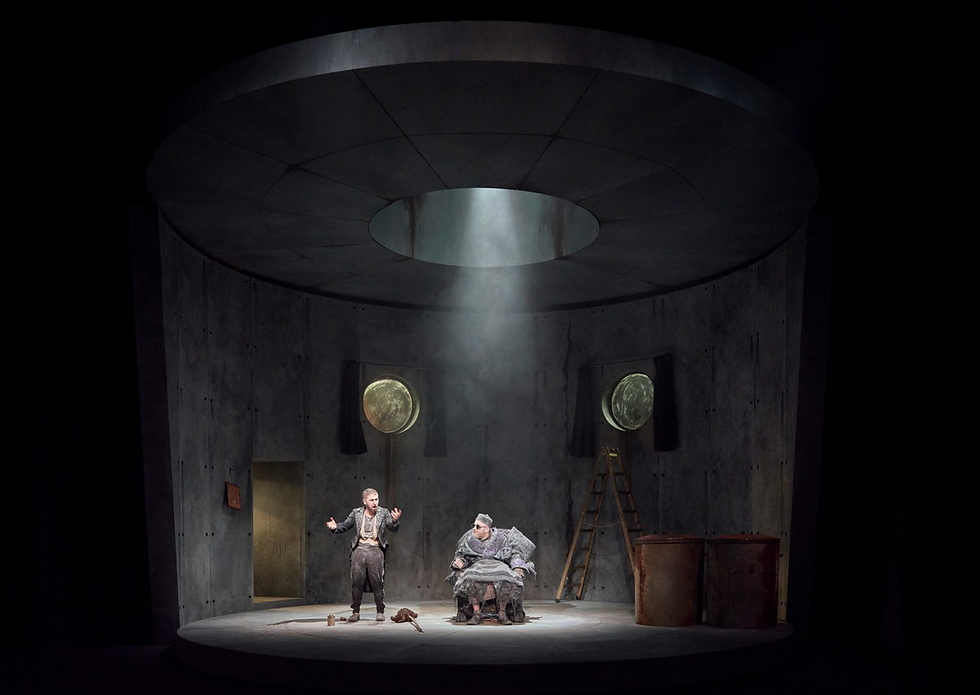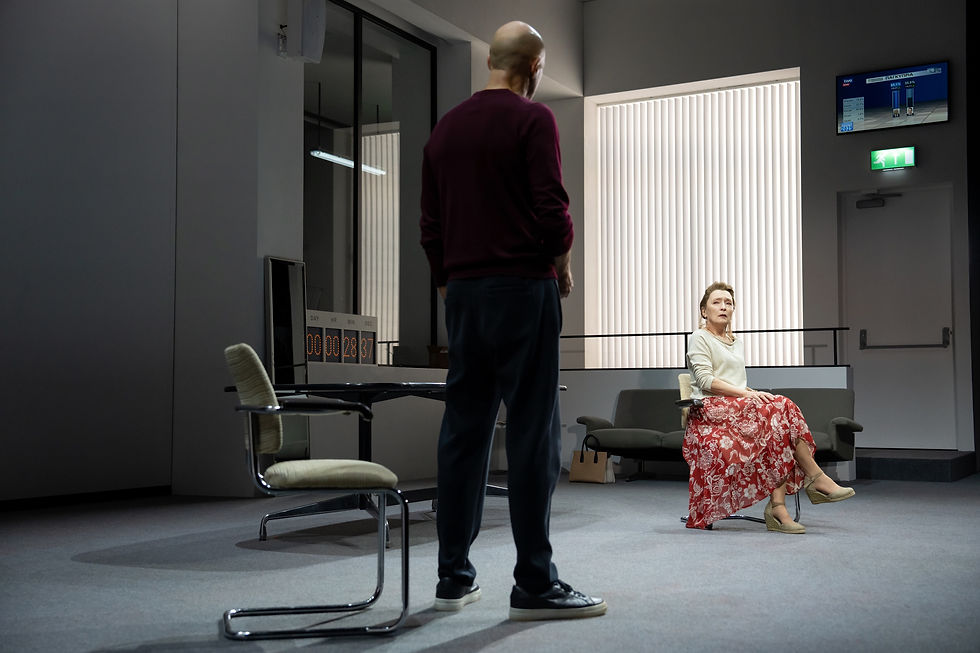Nearly Finished
- Jonathan Kalb
- Nov 4
- 4 min read
Updated: Nov 6

With a depressingly vacuous, celebrity-circus Waiting for Godot sucking up so much oxygen on Broadway, it’s a delight and relief to see Samuel Beckett produced at the Irish Arts Center by gifted and steely artists with proven talent at plumbing his work. The indomitable Garry Hynes, a Tony-winner and leader of Galway’s Druid Theatre for 5 decades, brought a beautifully limpid Godot to New York in 2018. Now she’s back with an equally strong Endgame starring two actors from that Godot. Rory Nolan and Aaron Monaghan, who played Pozzo and Gogo 7 years ago, have returned as Hamm and Clov.
Endgame, written in 1957, is sometimes described as a sort of sequel to Godot in which the central situation is pushed to a grim extreme in a grey, post-apocalyptic shelter rather than a deserted country road. In both plays, a clownish pair who seem incompletely conceived as fictional characters wards off boredom and death with repetitive routinized games, but their interactions are much nastier and airless in Endgame. Godot can actually accommodate a lot of improv and breezy relief by talented comedians, whereas Endgame is built around tightly rehearsed routines that harp relentlessly on the dark joke that creation is a bust and “the end” can’t come fast enough.

Hamm, to remind you, is the absurdly pompous, domineering, and ostensibly blind protagonist who spends the play in a rolling armchair because he can’t stand up. He amuses himself by constantly ordering Clov, who can’t sit down, to perform pointless tasks, the more pointless the better.
Hamm: I want to hear the sea.
Clov: You wouldn’t hear it.
Hamm: Even if you opened the window?
Clov: No.
Hamm: Then it’s not worth while opening it?
Clov: No.
Hamm (violently): Then open it!
Clov is Hamm’s seemingly slavish but slyly disobedient servant, who spices up his days by (among other life-hacks) arranging deliberate accidents, perhaps because they give him the illusion of agency.
(He gets up on the ladder, raises the telescope, lets it fall).
I did it on purpose.
This attitude of practiced insincerity is, along with the landscape of desolation, the distinctive feature of early Beckett, and Nolan and Monaghan are masterful at evoking it. They’re also remarkably courageous in their performing choices, which tend to be uncomfortably claustrophobic. Only the best Beckett actors fully accept that the plays don’t come alive when you fight against their restrictions; they do so when you twitch, squirm and wriggle within them in original ways.
If you go see this show, watch how Nolan and Monaghan handle the precision of their routines. Hamm, as his name suggests, is a self-aggrandizing blowhard who often grandiloquizes directly to the audience, but Nolan adds another quality to him: a desperation implicit in his strict habits. This effect is subtle but distinct. It emerges in the undeviating patterns and pinpoint timing of his exchanges with Monaghan, which help us gradually realize that he cares vastly more about playing to Clov than to us.
Their private gameplaying and playacting, we recognize, has wholly consumed them over time and is now terminally exhausting. It evidently extends even to the way they dress: Nolan in an old movie star’s bedraggled purple and black-lace robe and Monaghan in a filthy black tailcoat and vest like a stock comic servant. No wonder they vociferously hope that everything is “nearly finished.”

Another key element in the show is the portrayal of Nagg and Nell, Hamm’s legless parents who live in ashbins off to the side. Bosco Hogan and Marie Mullen provide a much-needed contrast to Nolan and Monaghan’s insularity. They play this couple as refreshingly goofy oldsters whose sweet nostalgic love for one another and (in Nagg’s case) genuine disdain for Hamm inject exactly the right dash of sincerity and direct feeling into the insincere darkness.
Still another high point is the set designed by Francis O’Connor. O’Connor also designed Hynes’s Godot in 2018. His country road back then featured a smooth egg-like stone, glowing lights around the stage, and a shadowy rear wall of brutalist polished concrete. His Endgame set is made entirely of polished concrete: a cylindrical room with high round windows and a flying saucer-like ceiling that evokes a missile silo, an industrial pump house, or a dungeon. Crucially, it’s an overtly theatrical place that perfectly complements Nolan and Monaghan’s overtly histrionic profiles.
My sole reservation about this fine production has to do with pain. I never believed that this Clov’s legs hurt. Clov says, “The pains in my legs! It’s unbelievable! Soon I won’t be able to think any more,” and yes, like everything else in the play, this remark could be disingenuous. As I watched Monaghan shuffle, plod, and dash about the stage the whole show at what appeared to be full strength, however, I couldn’t help thinking that the possibility of real pain (as opposed to the feigned kind) really has to be present in Endgame. Otherwise the play tilts discouragingly toward the “game” at the expense of the “end.”
By Samuel Beckett
Directed by Garry Hynes
Irish Arts Center




Comments